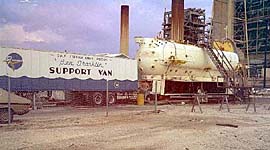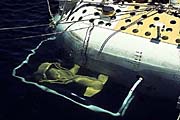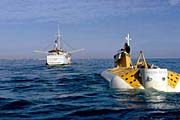From Sea to Shining Sea:
A Film Treatment by Paul Gasek and Gene Carl Feldman
Historical: NASA and Franklin scenes, running up to launch; Franklin test dives.
Original: May explains.
Exploration of the oceans and space are now scientifically linked in a formal way. However, that both missions - Apollo 11 to the Moon, and PX-15 to the Gulf Stream - should run concurrently no one ever intends or imagines. The ideal window to make a Gulf Stream drift dive begins in May, and the intention is to drift for the 30 days of June, before the Moon mission. However, during initial test dives, the Franklin is plagued with electrical problems. All of the Franklin’s systems, including propulsion, are battery powered. The enormous cells are slung outside and under the hull. The pressure compensation system to protect the cells from crushing ocean depths works well, but small flaws in the neoprene covering the 3/4" copper wires running from the batteries through the hull to the interior of the vessel drain electricity into the surrounding sea. The crew makes dive after dive, identifying and running down pinholes in the neoprene covering. The days tick by.
Historical: Franklin underwater on test dives.
Original: crew relates the story.
The Franklin is a prototype vessel, and the crew is untried as a team. The behavior of the sub has been anticipated theoretically, but before the mission can begin, all theory must be tested and the crew brought up to speed on the sub’s operation. Over the month-long mission, the crew will have to adjust the depth of the Franklin by achieving neutral buoyancy at many different depths. This will require skill in working with the dynamic equation of hull weight, displacement, thermal contraction and expansion, pressure, and ascertaining what small, delicate adjustments are necessary to rise or sink in the water column to desired depths.

![]()

On one of the first test dives, Piccard and Kazimir decide to dive to 1000 feet, and work out the precise amount of water to take on to achieve neutral buoyancy and stay the Franklin at 1000 feet. They ballast with seawater and begin to dive. They hit 1000 feet - and keep right on going!! At 1800 feet, the Franklin stops and stays. After recovering from extreme consternation, they figure out their oversight. Seawater temperature at the surface is 88 degrees - at 1000, it’s 55. The dive has been so rapid that the temperature of the Franklin’s hull cools more slowly than the surrounding seawater. At 1000 feet, the Franklin’s hull temperature is still cooling to 55 degrees, and continues to contract as it reaches and passes 1000 feet, sinking it lower in the water column, to 1800 feet - a significant error. A new component - hull cooling time - is added to the neutral buoyancy equation.

![]()

![]()

![]()

These and other problems and adjustments delay the launch of the Franklin’s mission until July 14th - two days before the launch of Apollo 11! The two missions are now slated to run concurrently. Yet the two missions, bound for very different destinations, the one to become famous, the other to remain unknown, share more than simply their dates.
PREVIOUS PAGE | Page 5 | NEXT PAGE